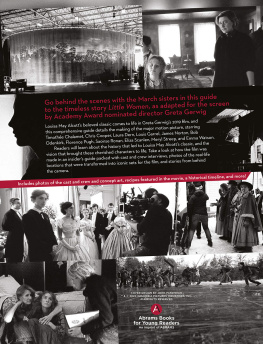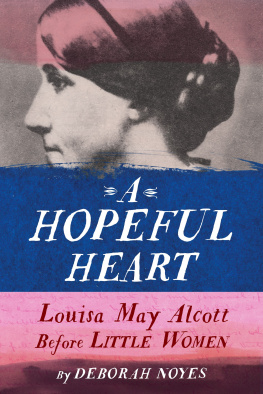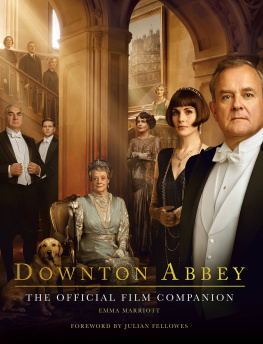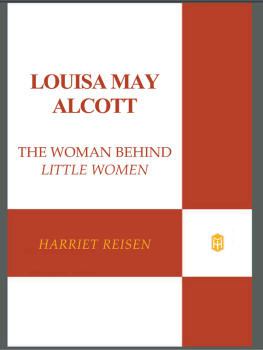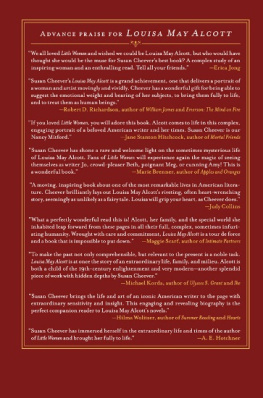Contents
Landmarks
Page List




Jo March, as played by Saoirse Ronan, at her writing desk
CHAPTER ONE
LOUISA MAY
ALCOTT
AND THE LEGACY OF
LITTLE WOMEN
I do think that families are the most beautiful things in all the world!
JO MARCH
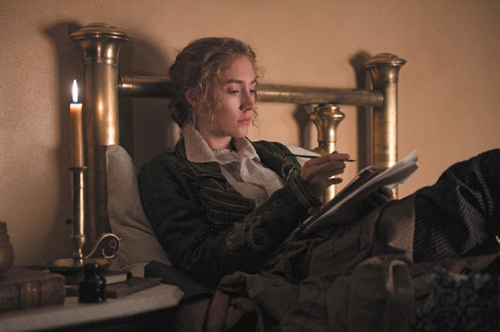
Ever the writer, Jo puts pen to page at the boarding house
Like all the best stories, this one has humble beginnings: at a small, hand-fashioned desk affixed to the windowsill of a second-floor bedroom in a ram-shackle house in Concord, Massachusetts. Built in the 1600s, the home was in poor condition when philosopher and educator Amos Bronson Alcott bought the residence for his family nearly two centuries later, in 1857. Yet one of the worlds most enduring literary masterpieces was written inside its modest walls.
Louisa May Alcotts semiautobiographical novel Little Women, or, Meg, Jo, Beth, and Amy was an immediate sensation upon its publication in 1868 and has remained a towering classic for decades. In 150 years, not only has the book never gone out of print, but it has been translated into upwards of fifty languages. In 2016, Little Women was named one of Times top 100 young adult books of all time, and some accounts suggest that more than ten million copies of the book have been sold.
Readers the world over remain riveted by Alcotts tenderly rendered depiction of life in nineteenth-century New England, where the fictional March family resides. Their accommodations might be modest, but their home is overflowing with love. Sisters Meg, Jo, Beth, and Amy live together with their adored mother, Marmee. With their father called to serve in the Civil War and their family fortune depleted, the women have few luxuries. Nevertheless, their lives are full and happy, sustained by mutual admiration and respect and the comfort they find in each others company.
Alcotts novel details the pivotal years in the March sisters lives as they make their way from adolescence into adulthood, and in writing the book, she brought many of her own experiences to the page. She herself served as the model for headstrong Jo, the boyish girl who cares passionately about her writing and vows never to marry for fear of losing her autonomy. Alcotts sisters, Anna, Lizzie, and May, inspired Jos siblings, each a well-drawn character in her own right. And just like the March girls, the Alcott women worshipped their mother, Abigail or Abba, whom they called Marmee.
Their father was a more complicated figure. He espoused progressive ideals about equality and maintained close friendships with writers Ralph Waldo Emerson and Henry David Thoreau, key voices in the Transcendentalist movement. Bronson Alcott lived a peripatetic existence, moving his family more than thirty times. He also founded a short-lived utopian community called Fruitlands, where residents bathed in cold water and ate only vegetables that grew above the ground. When the society collapsed after less than a year, Bronson opted not to pursue gainful employment, leaving the family largely destitute.
It was under these circumstances that Alcott began penning thrillers under the pseudonym A. M. Barnard, selling them to local weekly publications (titles included Paulines Passion and Punishment) and bringing in much-needed income. Eventually, her publisher asked her to write a tale that would appeal to girls. Her own home provided plenty of material. She has been quoted as saying that she never liked girls or knew many, except my sisters; but our queer plays and experiences may prove interesting, though I doubt it.
When Little Women opens, the March girls are knitting in the twilight, preparing for their first Christmas without their father. Meg, the oldest at sixteen, strikes a complaining tone, saddened by the fact that the familys meager circumstances have forced her to find work as a governess. Equally cross is fifteen-year-old Jo, short for Josephine, a bookworm who bemoans the fact that she wasnt a born a boy who could go and fight herself. Peacemaker Beth, a mature thirteen, suggests that washing dishes might be the worst work in the world, because it keeps her from practicing music. Young Amy, twelve, believes she is the most aggrieved, however, what with her entirely unsatisfactory nose and her inability to buy the new drawing pencils she so strongly desires.

Jo March, played by actor Saoirse Ronan, prepares to enter the boarding house
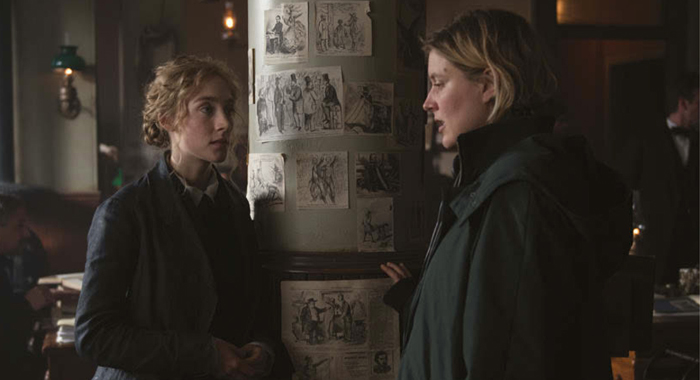
Saoirse Ronan discusses a scene with director Greta Gerwig
Whatever affectionate sisterly quarrels might arise among the Marches, their loyalty each other, and to their mother, is fierce and unwavering, though Jos ferocity might be the most steadfast trait of all. Of her family, she is the least interested in abiding by the rules of civil society. She longs only to invent wild plays or spend her hours writing in the confines of the attic that doubles as her study. She finds an unruly kindred spirit in the wealthy young man whose majestic house sits across the wayorphaned Theodore Laurence, who resides in empty opulence with his emotionally distant grandfather. Laurie, or Teddy as she calls him, becomes Jos closest friend and confidante, a mischievous soul mate whose love for the wild girl knows no bounds.
Jo stood apart as a singular heroine: angrily defiant, headstrong, and boldly clinging to youth rather than succumbing to adulthood and its expectations that women surrender their independence and live instead for their husbands and children. She was a transformative figure for readers who might never have dared to dream of a creative career, or, in fact, any career at all. In an interview for the Harry Potter films, author J. K. Rowling said: It is hard to overstate what she meant to a small, plain girl called Jo, who had a hot temper and a burning ambition to be a writer. Among the other luminaries who have declared their affinity for Jo: Gloria Steinem, Gertrude Stein, Simone de Beauvoir, Hillary Rodham Clinton, national poet laureate Tracy K. Smith, novelist Ann Petry, Supreme Court justices Sandra Day OConnor and Ruth Bader Ginsberg, and rock icon Patti Smith.
GREAT ADAPTATIONS
LOUISA MAY ALCOTTS BELOVED NOVEL HAS BEEN TOLD AND RETOLD COUNTLESS TIMES. HERES A PRIMER ON THE VARIOUS INCARNATIONS OF THE TIMELESS TALE.
ON THE BIG SCREEN
Ruby Miller was the first actor to play Jo in the first movie adaptation of Alcotts classic, though her performance in the British silent film has been lost to time. One year later, Dorothy Bernard took a turn in the lead role in a US silent production. But it was the 1933 black-and-white production directed by George Cukor that might be the most memorable early version. It stars Katharine Hepburn as the headstrong protagonist, won an Oscar for its screenplay, and was nominated for best picture and best director. In 1949, Hollywood revisited the novel once more, this time in Technicolor with then thirty-one-year-old June Allyson as the fifteen-year-old Jo and a young Elizabeth Taylor in a blond wig as Amy. In 1994, Winona Ryder was nominated for best actress for her turn as Jo in the Gillian Armstrongdirected film.

